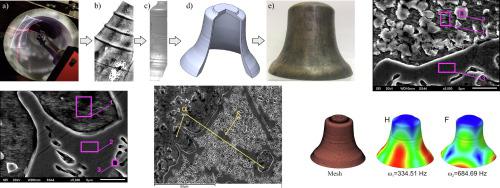Engineering Science and Technology, an International Journal ( IF 5.7 ) Pub Date : 2021-02-27 , DOI: 10.1016/j.jestch.2021.01.012 Dawid Cekus , Paweł Kwiatoń , Maciej Nadolski , Krzysztof Sokół

|
An important utility parameter of bells, including church bells, is their sound – that depends on geometry of the body, changes in section thickness and material from which they are made. Knowing the geometry of casting and chemical composition of the alloy, it seems that the current state of art allows recreating not only solid, but also acoustic properties of the casting. Hence, the purpose of this work is to make a casting using reverse engineering tools, compare acoustic properties of the newly formed bell with the prototype, and test material for a bell alloy. For the host and casted bell the note and octave are identical, the sound differs only in the number of cents away from the exact note. Compared with the numerical model, the acoustic properties of newly formed bell were found with slight deviations. The reasons for registered differences between the components of the original sound and the copy are seen as differences during melting, pouring and solidification processes of the alloy. Material tests carried out on samples taken from the new bell also showed microporosity of the casting and change in microhardness of the and eutectoid phase ( + ) along height of the bell cross-section. The chemical composition of bronze also varied along with the change of measuring points at the rib height and the fraction of eutectoid in the alloy structure. Material tests showed a significant influence of cast porosity on its acoustic properties.


























 京公网安备 11010802027423号
京公网安备 11010802027423号